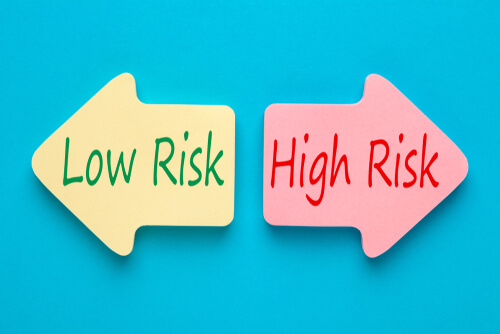When it comes to investing, risk and returns are closely connected. Usually, higher returns are linked to higher risks. On the other hand, lower rewards come with lower risks. In that case, you should know the difference between the two, plus their pros and cons. Earning this knowledge would help you make investing decisions easier.
Difference between low-risk and high-risk investments
Low-risk investments
Typically, low-risk investments involve less stake in your money or your portfolio’s overall value. Also, you might only get fewer gains, regardless of whether it’s in short-term or long-term advantages.
Because of its low-risk nature, it does not only mean you are protecting yourself from any chance of loss, but it is also a decision to ensure none of the possible losses will create a significant impact.
Here are some low-risk investments:
Fixed deposits
As investors who like to avoid risks as much as possible, they can benefit from fixed deposits (FDs). FDs are generally recommended in people’s to-invest list since they promise to give stable rewards and protect money.
FDs are offered by banks and even non-banking financial institutions (NBFCs). You can invest a fixed amount in a fixed deposit for a specific time at a set interest rate. Interest rates of fixed deposits depend on the financial institution’s terms. When investing in fixed deposits, your returns are guaranteed, withdrawals are flexible, and it would be easier to reach short-term financial goals.
Life insurance
A life insurance policy or an endowment plan is the primary way of providing financial security for one’s family in the future, especially if the provider is the breadwinner. Financial protection and peace of mind are the main benefits of life insurance.
Beneficiaries in your family would get benefits such as paying for living expenses previously covered by the insured individual’s income, credit card, medical bill payments, funeral and final expense costs coverage, and funding children’s tuition and expenses. Life insurance’s list of pros is a good reason for it to be considered a low-risk investment.
Savings account
Savings accounts are interest-generating deposit accounts kept in banks or other financial institutions. Although they only pay a modest interest rate, their security and reliability make them a good option as a low-risk investment and hold cash for reaching your short-term financial needs.
If you hold a savings account at the same institution where your primary checking account is, you could experience more efficiency benefits and greater convenience. Besides, transfers between accounts within the same institution are direct, and deposits or withdrawals from your checking account to your savings will be immediately effective.
High-risk investments
Getting involved with high-risk investments means you are willing to take chances while being completely aware that it might fail in its total value or performance. It is characterized by higher potential rewards. However, it carries more significant risks. High-risk investments are not for you if your risk tolerance is in bad shape, or you cannot manage risks well.
These are some high-risk investments:
Direct equities/investments
Investors who are comfortable enough to take on more risks can choose equities. Investing directly in stock markets is one strategy to maximize returns but remember the risks you could run into. Besides, stocks consistently outperform several asset classes in the long term. Not everyone is fit to try direct investment.
Before you directly invest in stocks, make sure that you do sufficient research on the different areas before buying a stock. Be familiar with the latest market developments and movements. Also, get a good understanding of companies’ balance sheets before investing in them.
Cryptocurrency
Cryptocurrencies make transferring funds between two parties easier and faster than standard money transfers. Also, you can transfer without a third party, such as banks or credit card companies. Decentralized transfers are secured by public and private keys and various forms of incentive systems like proof of work or proof of stake.
Despite crypto’s ease of transfers, they leave digital trails that agencies like the Federal Bureau of Investigation could track. This gives the government and some authorities the ability to follow financial transactions. Also, crypto became a popular tool for criminals to conduct money laundering and illicit buys. In addition, it became a common platform for hackers for ransomware activities.
Unit-linked insurance plans
Unit-linked insurance plans, or ULIPs, are a kind of endowment plan where the investments in your portfolio are linked to stock markets with a life cover. If you can take risks, you can find a ULIP suitable for your investment goals. ULIPs are flexible, making them a great investment option for investors with a wide range of risk tolerance.
Which is better for you?
After differentiating the two investments, you can choose which is better. To make the right pick, be clear about your investment goals and measure how much risk you can handle or manage. Nevertheless, a balanced portfolio must include both low-risk and high-risk investments. It is essential to diversify your holdings into both low and high-risk investment. Besides, safer options limit risks and offer stability, while high-risk investments provide higher returns.
Even though high-risk investments have a higher possibility of greater profits, they make your capital exposed to more risk. However, high-risk investments yield bigger rewards if they go according to plan. On the other hand, if you are still uncomfortable facing risks, low-risk investments will give you assurance about the rarity of losses. But you would only gain smaller rewards.
Consider balancing risky and safe investments. If you diversify your portfolio, you can experience a risk reduction while getting more chances of higher profits. Investing more in different types of investments can help lessen your overall exposure to risks.
Before deciding on which one to tackle, do a self-assessment. Know if you are more willing to deal with risks and get higher gains in return or are more comfortable staying in the safe zone but only receiving smaller rewards. Remember the relation between risk and return to understand better how to decide. However, if you need help deciding which path to take, you can always seek assistance from a financial advisor or expert for deciding.











